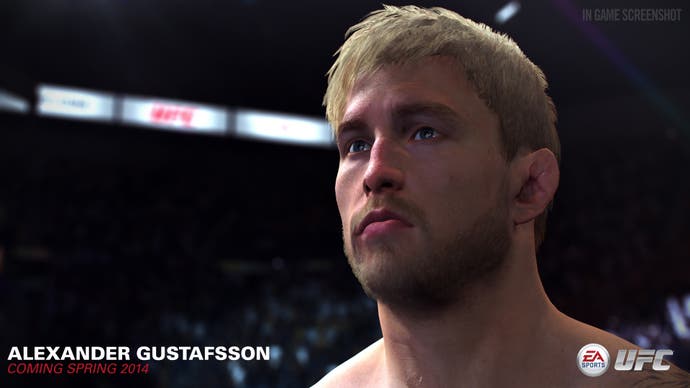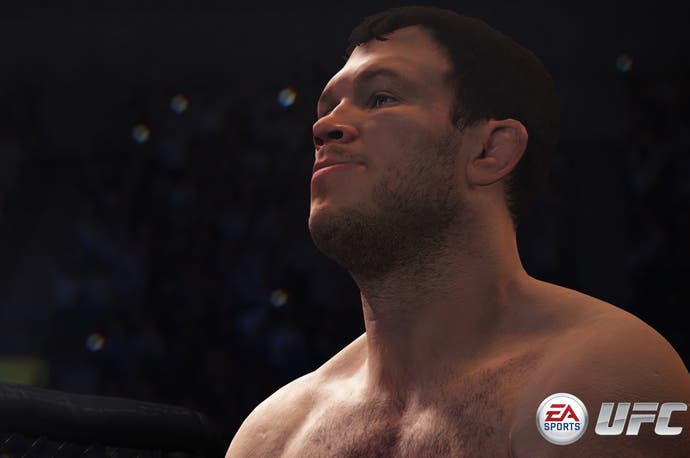EA Sports UFC preview: The MMA genre re-disputed
With EA Sports' Ignite engine coming up against the UFC licence, the results are looking promising.
Last year proved to be one of the most progressive in UFC history. Not only did we see women fighting in The Octagon for the first time, we saw two of the sport's most iconic champions - Anderson Silva and Georges St-Pierre - lose their respective titles. Silva lost twice to Chris Weidman, with the second fight ending in a clean break of The Spider's leg, while St-Pierre vacated the title after a highly controversial win over Johny Hendricks. It feels like we're heading into a new era of MMA, and it's not something that begins and ends with the physical sport itself.
It's no secret that the Undisputed series was the MMA champion over the last console generation. UFC 2009 Undisputed proved that the sport could be made into something worthy, and over two subsequent games Yuke's refined the art of takedowns and transitions. But now that EA Sports has the UFC license and Yuke's has gone back to working with the WWE, Dana White has gone from declaring war on EA to helping it build a new generation of UFC fighting games. Still, after all the trash talk that's been thrown around in the past, what was that first meeting like?
"It was totally cool", explains EA Sports UFC producer Brian Hayes. "We announced the licensing with the UFC back at E3 2012, and then literally two weeks later, Dana White, Lorenzo Feritta and some other key people came to the studio and gave a presentation to the whole team. We then gave a presentation on what our plans were and it went from there." That meeting was over one and a half years ago, and since then, Hayes and his team have put together a fighting system that feels less like an evolution of EA Sports MMA and more like a combination of Fight Night and Undisputed.

This isn't a total surprise when you consider that EA Canada, as opposed to EA Tiburon, is heading up development. The Total Strike Control system that let you use the right analogue stick to throw punches and kicks in EA Sports MMA is nowhere to be seen. In its place, attacks are mapped out Tekken-style to the face buttons in a more traditional manner. Tapping them on their own delivers the expected jabs and front kicks, while using a combination of directional inputs and one of the two strike modifiers expands your offensive repertoire dramatically. There's everything from superman punches and spinning back fists to flashy Capoeira kicks.
To block a strike, you simply have to hold down the right shoulder button for an overall defence, but if you commit to raising your guard high or low, you can nullify a strike completely while leaving the other half of your body exposed. You can also duck and weave away from incoming strikes by double tapping on the left analogue stick. It all comes together to form a fluid striking system that mirrors the stand-up principles of past UFC games. The only thing I couldn't find was a feint system for throwing fake strikes, although it seems likely it's buried in the control scheme somewhere.

One thing that has been included is the ability to launch strikes off the cage. "The first time Anthony Pettis did the Showtime Kick, people were thinking it was probably a one off", Hayes reflects. "But when Pettis followed it up with a knee off the cage against Donald Cerrone and then Jose Aldo landed a superman punch off the cage against Frankie Edgar, it felt like a videogame was the perfect place to see it happen a little more often." From a gameplay perspective, it feels like another tool in the box rather than a broken gimmick.
After years of working on the Fight Night series, it's fair to say that EA Canada knows how to throw a punch. It's already reflected in EA Sports UFC's striking system with the swiftness of the straights and the momentum of the uppercuts. But the real challenge was always going to be the ground game and the submission system. As accomplished as Undisputed and EA Sports MMA were in their own right, the instinctive nature of throwing a punch with a button was far removed from transitioning between side control and full mount with the flick of the analogue stick.
"You have a sport that you can play with your eyes closed and a game where you have to play with your eyes open", Hayes offers when asked about the challenges of replicating Brazilian jiu-jitsu on a controller. It's an apt assessment that reinforces why MMA is such a tricky sport to adapt into a game, especially if you're trying to strike an even balance between accessibility and realism. It also explains why the team has gone with a ground game that's reminiscent of Undisputed. You set up a pass by holding the right analogue stick in one direction, and then by spinning the stick when the timing's right, you can get to a more dominant position.
There's no such thing as a major or minor transition in this game. You just set up a pass with strikes and hope the opponent doesn't match your direction when you push forward. Takedowns also come courtesy of the right analogue stick, although the window for stuffing a takedown attempt feels a bit too generous. But considering this build didn't have complete animations for the clinch - which meant I had to avoid that side of the game completely - it's clear that Hayes and his team are fine tuning certain aspects of the fighting system.
This includes the submission system, something which always sparks controversy in any MMA game that offers it as a way to win. Hayes described how the team prototyped at least eight different submission systems before coming up with the final design. It's not the easiest system to describe in writing, but suffice to say that the defending player pushes the right analogue stick in one of four directions to escape the submission while the attacking player tries to match the direction to keep them pinned. If the attacker can hold the opponent in place long enough, a prompt will briefly flash up on the screen.

Hit it in time, and the submission will progress to the next stage, and if you pass all stages (of a possible five), the desired effect will be achieved. It's less like the notorious shine system from the first two Undisputed games and more like the overlap system from Undisputed 3 and the choke system from EA Sports MMA. You can't chain submissions into each other, but it feels like the attacking player has to work harder to get the submission locked in. So unless you're playing as Demian Maia or Ronaldo Souza, it might make more sense to go for the traditional ground and pound.
The final roster has yet to be confirmed, but as I picked Alexander Gustafsson to play a few final rounds against Hayes's formidable Jon Jones, I took a few minutes to really take in what EA Canada and the Ignite engine had achieved. The detailing on the fighters is a clear step above what's gone before. When Jones pulled in Gustafsson for a Twister submission attempt, you could see the veins popping out of the Swede's head, and when the two light heavyweights started pacing across The Octagon, you could see each individual toe spreading out on the canvas as their feet touched the ground.
There's still so much about EA Sports UFC that we don't know. We don't know how the career mode will be handled. We don't know what to expect from the online features. We don't know how many female fighters will be in the game. And we don't know if Bruce Buffer will feature as a secret unlockable fighter like the original UFC game on the Dreamcast. What's clear is that EA Canada is trying to craft an authentic MMA game. One that not only ushers in a new generation of sports fighting games, but establishes a solid foundation that can be built upon for many years to come.






